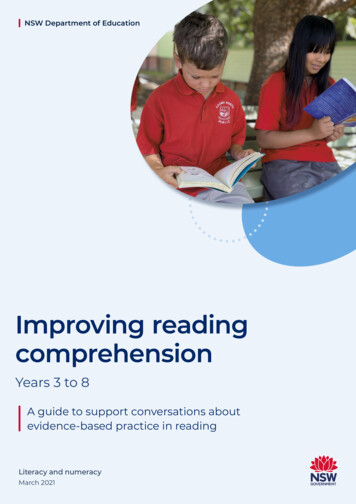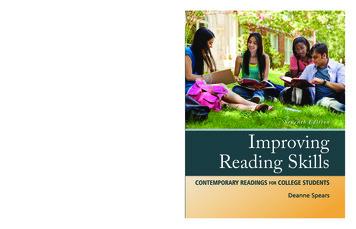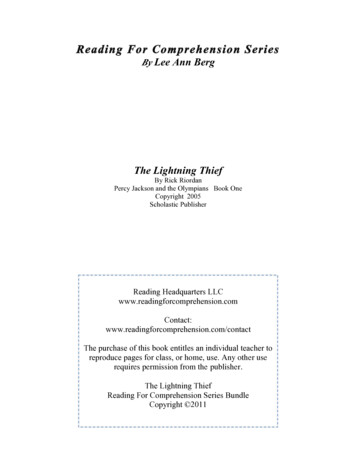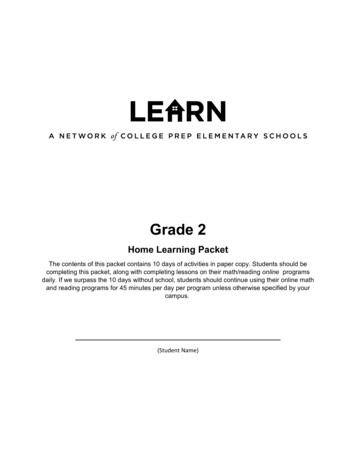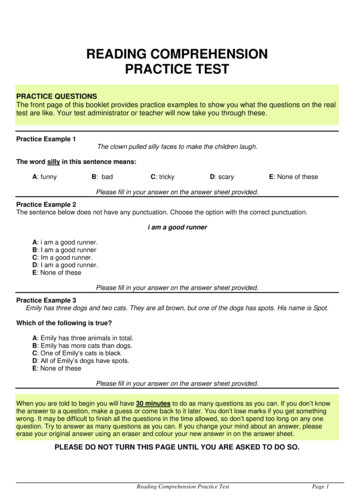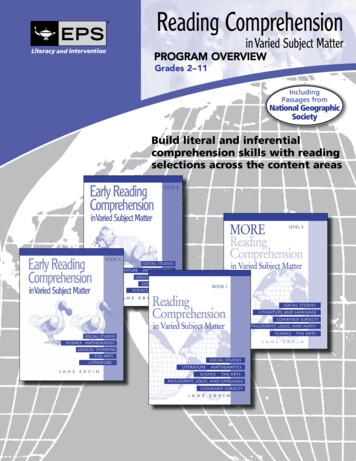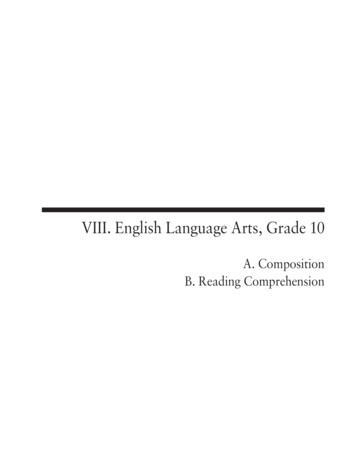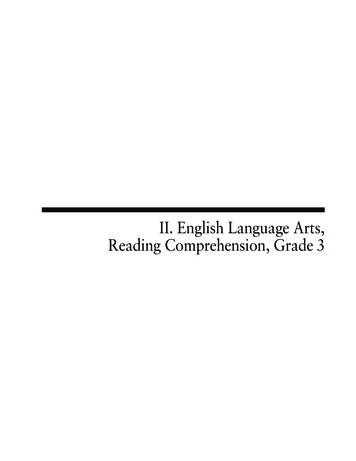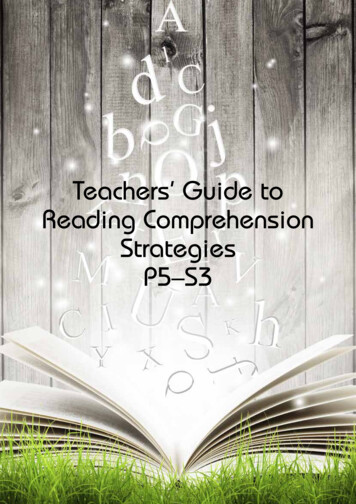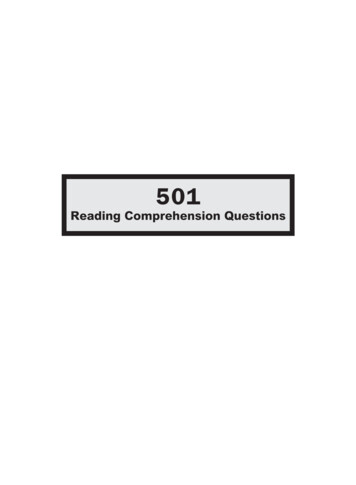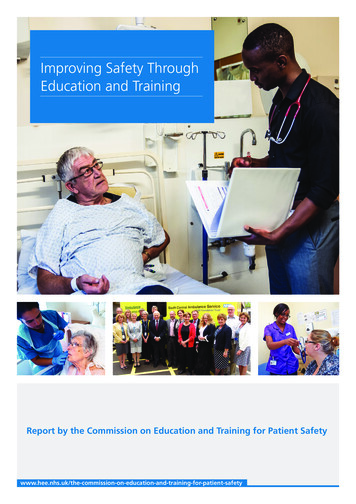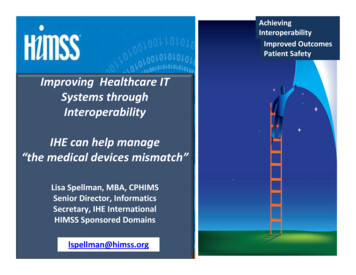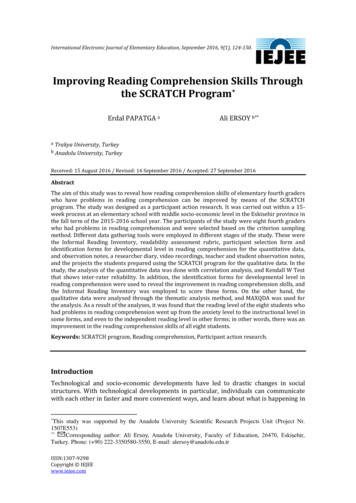
Transcription
International Electronic Journal of Elementary Education, September 2016, 9(1), 124-150.Improving Reading Comprehension Skills Throughthe SCRATCH Program*Erdal PAPATGA aabAli ERSOY b**Trakya University, TurkeyAnadolu University, TurkeyReceived: 15 August 2016 / Revised: 16 September 2016 / Accepted: 27 September 2016AbstractThe aim of this study was to reveal how reading comprehension skills of elementary fourth graderswho have problems in reading comprehension can be improved by means of the SCRATCHprogram. The study was designed as a participant action research. It was carried out within a 15week process at an elementary school with middle socio-economic level in the Eskisehir province inthe fall term of the 2015-2016 school year. The participants of the study were eight fourth graderswho had problems in reading comprehension and were selected based on the criterion samplingmethod. Different data gathering tools were employed in different stages of the study. These werethe Informal Reading Inventory, readability assessment rubric, participant selection form andidentification forms for developmental level in reading comprehension for the quantitative data,and observation notes, a researcher diary, video recordings, teacher and student observation notes,and the projects the students prepared using the SCRATCH program for the qualitative data. In thestudy, the analysis of the quantitative data was done with correlation analysis, and Kendall W Testthat shows inter-rater reliability. In addition, the identification forms for developmental level inreading comprehension were used to reveal the improvement in reading comprehension skills, andthe Informal Reading Inventory was employed to score these forms. On the other hand, thequalitative data were analysed through the thematic analysis method, and MAXQDA was used forthe analysis. As a result of the analyses, it was found that the reading level of the eight students whohad problems in reading comprehension went up from the anxiety level to the instructional level insome forms, and even to the independent reading level in other forms; in other words, there was animprovement in the reading comprehension skills of all eight students.Keywords: SCRATCH program, Reading comprehension, Participant action research.IntroductionTechnological and socio-economic developments have led to drastic changes in socialstructures. With technological developments in particular, individuals can communicatewith each other in faster and more convenient ways, and learn about what is happening in*This study was supported by the Anadolu University Scientific Research Projects Unit (Project Nr.1507E553)**Corresponding author: Ali Ersoy, Anadolu University, Faculty of Education, 26470, Eskişehir,Turkey. Phone: ( 90) 222-3350580-3550, E-mail: alersoy@anadolu.edu.trISSN:1307-9298Copyright IEJEEwww.iejee.com
Improving Reading Comprehension Skills Through the SCRATCH Program / Papatga & Ersoydaily life more quickly. Technology that appeared in every area of human life has alsobrought improvements and changes to the field of education, and in line with thesechanges, how technology can be used in education has been a current issue. In this regard,educational programs and instructional methods and techniques need to be developedand renewed in order for education to adapt to technological changes; in other words,technology should be integrated into education.Elementary school in which individuals receive basic education is the first stage of formaleducation, in that it has prominent roles in instructional activities. Equipping studentswith language skills is the most important among these roles. Teaching reading andwriting in particular is of significance for individuals to acquire and develop readingcomprehension skills in the next grades. Reading and writing classes in elementary schoolhave an important function in teaching students reading comprehension skills.The reading comprehension process is about understanding the opinions or messages thatthe author wants to deliver intentionally (May, & Rizzardi, 2002). Reading comprehensionskills are those that individuals can not only use in their academic life, but also their wholelife. Besides, these are the skills that they can use in all courses, not only the course relatedto their mother tongue. Students' achievement in reading comprehension forms the basefor their success in other courses (Bloom, 1995). Research has revealed that readingcomprehension is directly related to the achievement in science (O'Reilly, & McNamara,2007) and mathematics (Vilenius-Tuohimaa, Aunola, & Nurmi, 2008; Walker, Zhang, &Surber, 2008). In an attempt to teach reading comprehension skills that are regarded ashaving great importance, educators and teachers can use different strategies, methods,techniques and tools in reading comprehension activities.Reading comprehension is among the basic skills that should be taught to children in thefirst years of elementary school. If they can acquire reading comprehension skills, they canbe successful in both school courses and life. Acquiring reading comprehension skillsseems to be even more important and functional especially in elementary school that isthe first period of children's school years. Students use these skills in all their courses, andtheir academic life is directly affected by such skills.In exams that are administrated at the international level such the Programme forInternational Student Assessment (PISA), the Trends in International Mathematics andScience Study, (TIMMS) and the Progress in International Reading Literacy Study (PIRLS),there are questions included to measure reading comprehension skills. Moreover, thecontents of the PIRLS exam consist of questions only related to reading comprehension.Additionally, in most of the exams that students are required to take throughout theiracademic life, it is aimed to determine whether they can use reading comprehension skills.In this respect, equipping students with these skills is of utmost importance.According to the results of some studies, among the reasons why Turkish students get lowscores in reading, mathematics and science sections of international exams (PISA, TIMMSand PIRLS) is that they are not competent in reading comprehension (Çavuşoğlu, 2010;Özçelik, 2011; Ulu, 2011; Uzun, 2010). Based on the first author's observations andexperiences in his elementary school teaching process along with the feedback he receivedfrom his colleagues, it was asserted that a considerable proportion of elementary schoolstudents have negative attitudes and poor motivation towards, and they have seriousproblems in reading comprehension. Besides, in a literature review, it was seen that one ofthe major problems regarding mother tongue education is reading comprehension, andthe problems experienced in reading comprehension negatively affect other courses aswell (Çavuşoğlu, 2010; Karatay, 2014; O'Reilly, & McNamara, 2007; Özçelik, 2011; Ulu,2011; Uzun, 2010; Vilenius-Tuohimaa et al., 2008; Walker et al., 2008). With the125
International Electronic Journal of ElementaryEducationVol.9, Issue1, 124-150, September 2016developments in technology particularly, the idea to use technology in readingcomprehension activities has come up. Consequently, the researchers thought that the useof technology in reading comprehension activities should be studied.Although there are many studies on the use of technology in education, those that focus onusing technology to improve reading comprehension skills have been limited (BerktaşTürkmen, 2001;Brown, 2006; Doty, 1999; Maddox, 2013; Stevens, 2014; Thooft, 2011). Inthis regard, the use of computer programs and games that are welcomed by elementaryschool students in reading comprehension activities has come to fore.There have been efforts to make computer programs and games suitable for students'grades, developmental levels and ages, and use them more effectively. In this process,computer programs have been developed which would be suitable to students' levels andensure continuous attention, facilitate the achievement of course objectives, and enhanceteacher and parent support. One of these programs, SCRATCH, is a program prepared inaccordance with all age levels, and that has an educational goal. It is argued that by meansof the SCRATCH program, technology can be effectively used in education, students'attention can be easily drawn to the lesson, their reading motivation can be increased, andtheir skills of using technology can be developed.The SCRATCH program that is suitable to elementary school students' level and usedworld-wide, and also approved by the Ministry of National Education and included in itswebsite for the use of teachers contains technical and instructional tools that can be usedin reading comprehension activities. Furthermore, students who have problems in readingcomprehension should be identified, and taught reading comprehension skills. In thisregard, it was contemplated how the SCRATCH program can be used to improve thereading comprehension skills of students who have problems in reading comprehension.The research problem emerged based on this contemplation.The aim of this study was to reveal how reading comprehension skills of elementaryfourth graders who have problems in reading comprehension can be improved by meansof the SCRATCH program. Based on this aim, the following research questions wereaddressed in the study:1. What are the pre-implementation reading comprehension scores and percentages ofthe students who have problems in reading comprehension?2. How is the improvement of these students' reading comprehension skillsthroughout the implementation process?MethodDesignThis study was conducted according to the action research design. Action research is acooperative research approach that individuals employ with systematic actions that theyperform towards the solution of certain problems. Such an approach is the one in whichindividuals aim to examine their problems and especially the problems affecting thesociety by means of reconciliatory, democratic and participatory strategies (Berg, 2001).In the field of education, action research is described as a systematic process that isconducted to solve the problems and improve the existing status (Tomal, 2010).In the literature, action research is categorised in different ways (Berg, 2001; Bogdan, &Biklen, 2007; Hendricks, 2006; Mills; 2003; Morton, 2005; O’Brien, 2001). For instance,Berg (2001) states that action research studies are of three types that are technical actionresearch, practical action research, and emancipating action research. Mills (2003) divides126
Improving Reading Comprehension Skills Through the SCRATCH Program / Papatga & Ersoyaction research into two as in critical action research and practical action research studies.Bogdan and Biklen (2007) classify action research as political action research andparticipant action research. Hendricks (2006) divides action research into four typesincluding cooperative, critical, in-class and participant action research studies.Within the scope of this study, Hendricks (2006) and Bogdan and Biklen’s (2007) actionresearch types were considered, and among these types, participant action research waspreferred since the first author of the study had the practitioner role in the process, andthe SCRATCH program was used in reading comprehension activities for the first time.Consequently, the study was planned and conducted in accordance with participant actionresearch.The study was designed as a participant action research. The research process ispresented in Figure 1.Research Design Participant Action ResearchParticipants and Environment Criterion Sampling Method An Elemantary School with Middle Socio-Economic Level Eight Elementary School Students Having Problems in Reading Comprehension Science and Technology Lab in the Elementary SchoolData Gathering Tools Informal Reading Inventory (Quan) Readability Evaluation Rubric (Quan) Participant Selection Forms (Quan) Identification Form for Developmental Level in Reading Comprehension (Quan) Identification Form for Developmental Level in Reading ComprehensionAdministered to Whole Class (Quan) Observation Notes (Qual) Researcher Diary (Qual) Video Recordings (Lessons- Students' Computer Screens) (Qual) Students' Scratch Projects (Qual) Teacher Interview Form (Qual) Student Interview Form (Qual)Data Analysis Correlation Analysis (Quan) Kendall W Test (Quan) Thematic Analysis (Qual)Figure 1: Research ProcessQual: Qualitative, Quan: QuantitativeParticipantsSelection of the schools: Criterion sampling, a purposeful sampling method, was used in theselection of both the schools and students. The criterion sampling method is a commonstrategy for selecting a sample that emphasize reviewing and examining all cases thatmeet predetermined and important criteria (Patton, 2002). In the study, the schools wherethe study would be conducted was firstly selected. In order to determine the schools atwhich students have the most difficulty in reading comprehension, exploratory127
International Electronic Journal of ElementaryEducationVol.9, Issue1, 124-150, September 2016observations were made in schools located in regions with high, middle and low socioeconomic levels. Following these observations by the first author, three elementaryschools were selected based on the criteria below:1.2.3.4.Being located in the Tepebasi district of the Eskisehir province,Including one school from each socio-economic level (high-middle-low),Voluntary participation of administrators, teachers and students to the study,Having the lowest scores according to the results of the participant selection forms.As a result of the exploratory observations, and evaluations with colleagues andelementary school teachers regarding the research topic, the first author decided toinclude three elementary schools in the Eskisehir province within the research process.These schools were classified as Elementary School A (high socio-economic level),Elementary School B (middle socio-economic level) and Elementary School C (low socioeconomic level). All fourth graders in these schools were administered the ParticipantSelection Forms developed by the researchers. At the end of these forms that consisted ofa narrative text and an informative text, 10 open-ended questions were included related toeach text. These forms were administered to a total of 561 fourth graders in the threeschools. Correlation analysis was then conducted on the data gathered through the formsby using SPSS 22. The first author scored the students' answers in the forms, but anindependent expert also evaluated these forms to ensure the objectivity and reliability ofthe first author's scoring. The relationship between the scores was examined to reveal theinter-rater reliability. Correlation analysis was conducted in this respect. The inter-ratercorrelation coefficient is presented in Table 1.Table 1. Correlation Between the Raters' ScoresRater1-Rater2p .01n561r.979**p.000As is seen in Table 1, it can be stated that there was a strong and positive relationship atsignificant level between the scores of the two raters (r 0.979, p .01). In other words, thescorings of the raters were found to be consistent to each other, and it can be argued thatthe first author's scoring was reliable. At this point, it was accepted that the scoresevaluated by the first author could be used in school selection. This was followed by theprocess of selecting the school with the lowest reading comprehension scores.The first form administered in this process was the one with the narrative text. Based onthe data gathered through this form, the reading comprehension mean scores of theschools were calculated by using SPSS 22. The results of this calculation are presented inTable 2 below.Table 2. Reading Comprehension Mean Scores of the Schools in the Narrative 70sd5.185.874.115.34As can be seen in Table 2, Elementary School B was found to have the lowest readingcomprehension mean score among the three elementary school in the narrative text type(M 12.22). Based on this result, it can be argued that the students in Elementary School Bhad more difficulty in reading comprehension.128
Improving Reading Comprehension Skills Through the SCRATCH Program / Papatga & ErsoyIn the school selection, the form with the informative text was also administered. Thereading comprehension mean scores of the schools in the informative text were againcalculated by using SPSS 22. The results are presented in Table 3 below.Table 3. Reading Comprehension Mean Scores of the Schools in the Informative .784.7174.8314.5044.824As is seen in Table 3, Elementary School B had the lowest reading comprehension meanscore among the three elementary schools in the informative text type (M 9.64). In otherwords, it can be argued that the students in Elementary School B had more difficulty inreading comprehension. Elementary School B was found to have the lowest mean scoreaccording to the results in both the narrative text and the informative text, and it wasdecided to carry out the study in this school.Selection of the students: After the school where the study would be conducted wasdecided, the students were selected by means of the criterion sampling method, as was thecase in the previous process. The primary criterion that was required for the students washaving difficulty in reading comprehension. In addition, the following criteria were alsorequired to be selected as a participant in the study:Students should;1. be fourth graders,2. have problems in reading comprehension,3. have reading comprehension levels between 0% and 50%, or in other words, atanxiety level,4. not have started reading and writing only just,5. not have any mental disabilities that prevent them from comprehending what theyread,6. have their parents' voluntary approval for participating in the study,7. be willing to participate in the study, and8. be using tools such as a keyboard and a mouse at the basic level.In this step, the first author went through the list of all fourth graders in ElementarySchool B, and identified that students whose reading comprehension was at anxiety level(i.e. between 0% and 50%). Consequently, one of the classes had 11 students whosereading comprehension was at anxiety level. The teacher of this class stated that hisstudents indeed had serious problems in reading comprehension. For this reason, theteacher specifically asked for his students to be selected for the study. He indicated thatthe 11 students who had problems in reading comprehension were those with the lowestacademic achievement, and he could give all kinds of support of they were to be includedin the study and help the researcher to take the consent of their parents. The first authorthereupon decided to select all of the participants from this class, and reflected thisdecision in his diary as in the following (Researcher Diary [RD], 06.11.2015):Because the elementary school teacher complained about his students' problems inreading comprehension, and asked the study to be conducted in his class, I decided toinclude the first eight students from this class with the lowest reading comprehensionlevel.129
International Electronic Journal of ElementaryEducationVol.9, Issue1, 124-150, September 2016Students: Eight fourth graders who were studying in an elementary school with middlesocio-economic level in the Eskisehir province, and whose reading comprehension was atanxiety level participated in the study. In the selection of the participants, the opinions oftheir elementary school teacher, the counselling teacher of the school and the secondauthor were considered. The students were selected based on these opinions.In this process, the issue of whether the students could use tools such as a keyboard and amouse was also considered, and they were selected accordingly. All of the students wereobserved to have technology skills at the level of using a computer, a mouse and theScratch program which will be employed in the study (RD, 07.10.2015). The demographiccharacteristics of the students who were selected as participants are presented in Table 4.Table 4. Demographic Characteristics of the StudentsStudent Name 91010101010Class teacher: The class teacher had a 24-year experience. He worked in Erzurum, Yalovaand Eskisehir during his professional life. Currently, he has been working as anelementary school teacher in Eskisehir for 18 years. He has been teaching in the schoolwhere he currently works for four years. He has been with this class since first grade(Teacher Interview, 04.01.2016).First author [Researcher]: The researcher graduated from the elementary teachingundergraduate program of Trakya University, Faculty of Education, and earned hisMaster's degree in elementary education in the same university. He completed his doctoralstudies in the PhD program on elementary teaching at the Graduate School of EducationalSciences, Anadolu University. He is mainly interested in reading comprehension as aresearch topic. Particularly during his experience as an elementary school teacher, heobserved that students have problems mostly in reading comprehension. He also witnessproblems in this aspect of language use in his interviews with elementary school teachersand his observations in schools during his assistantship at the faculty. He focused on thisissue in the process of choosing a topic for his PhD dissertation, and elaborated hisresearch on reading comprehension.Validity committee: In order to conduct the validity analyses and provide the researcherwith a critical perspective within the process, a validity committee consisting of experts inqualitative research and Turkish language teaching. Three individuals took part in thiscommittee. The meetings of the validity committee were held on Mondays every weekregularly. The researcher attended the meetings of the validity committee at the beginningof the week after his application every week. The researcher conducted the macroanalyses of the videos recorded during the applications and video recording of thestudents' computer screens. Additionally, the researcher analysed the students' Scratchprojects, pre-, during- and post-intervention interviews with the students and the teacher,and the student and researcher diaries, and obtained the data out of these analyses. Allthese data were presented to the validity committee. The analyses were discussed in thecommittee and the action plans for the following weeks were determined. These actionplans were recorded in the Committee's Decision Book as the committee decisions.Besides, the committee meetings were also video-recorded. The first author transcribed130
Improving Reading Comprehension Skills Through the SCRATCH Program / Papatga & Ersoyand analysed the videos after the meetings. These analyses were recorded in theCommittee's Decision Book as the findings. The first of the committee meetings was heldon 02.11.2015, in the week when the teaching of the Scratch program to the studentsfinished. The last meeting was held on 21.12.2015, in the week when the applicationprocess ended, and there were eight committee meetings in total.Thesis supervising committee: The three faculty members in the thesis supervisingcommittee were the remaining participants of the study. One of these faculty memberswas the supervisor of the researcher who has expertise in qualitative research andelementary education. The second member was an expert in Turkish language teachingand elementary education. The last member was an expert in instructional strategies andeducational programs.Research EnvironmentThe study was carried out in the science lab of Elementary School B. The lab includes tworooms, one of which is a small room and the other big. The small room was used as theresearch environment. It was allocated by the school administration. Four student desks,eight student chairs, one teacher's desk and one teacher's chair were put in this smallroom, which was normally empty. The student desks were placed to face each other in tworows. They and the teacher's desk were situated in a U-shape. The research environmentis shown in Figure 2.Figure 2. Research EnvironmentPreparation of the TextsThe narrative and informative texts employed in this study were prepared by the firstauthor. After the literature review, he decided on the topic, type and theme of the texts(RD, 01.05.2015). Thirteen of the 15 texts prepared were used in the study. Three of thesetexts were those used in the participant selection process, two were used in the pilotstudy, and six were for the actual implementation. In addition to these texts, two textswere prepared to be administered to the whole class at the end of the process.The difficulty levels of the texts were calculated by using the "readability formula" ofAteşman (1997) who adapted the Flesch formula to Turkish. In this regard, the difficultylevels of the texts were determined as easy, moderate and difficult. The opinions ofacademics and elementary school teachers who were experts in Turkish language teaching131
International Electronic Journal of ElementaryEducationVol.9, Issue1, 124-150, September 2016were then asked. After the experts' opinions were received, the necessary modificationswere made and the difficulty levels of the texts were determined, these texts werepresented to ten students and they were asked to fill the readability evaluation rubric(Ateş, Çetinkaya, & Yıldırım, 2012). The students' rating on this rubric showed that all ofthe texts were suitable to their levels. The type of the texts, for which form they wereprepared, the themes they were related to, and their difficulty levels are presented inTable 5.Table 5. Information Regarding the Text Types, Themes, and FormsText TitleText TypeThemeForm for Which theText Would be UsedDifficultyLevelSocial EtiquetteInformativeIndividual and SocietyParticipant tion, Consumptionand EfficiencyParticipant SelectionFormModerateMoney SavedNarrativeProduction, Consumptionand EfficiencyParticipant SelectionFormModerateRecyclingNarrativeProduction, Consumptionand EfficiencyPilot StudyModerateCars of theRevolutionNarrativeProduction, Consumptionand EfficiencyPilot StudyModerateSelim'sBelongingsNarrativeProduction, Consumptionand EfficiencyActual ImplementationEasyThe Farmer'sInheritanceNarrativeProduction, Consumptionand EfficiencyActual ImplementationModerateSevda and AuntNurgülNarrativeIndividual and SocietyActual ImplementationDifficultStarfishInformativeHealth and EnvironmentActual ImplementationModerateJourney of theBreadInformativeProduction, Consumptionand EfficiencyActual ImplementationEasyApricotInformativeTurkey, My BelovedCountryActual ImplementationDifficultFluInformativeHealth and EnvironmentTo the Whole Class atthe End of theImplementationModerateA Day with theGermsNarrativeHealth and EnvironmentTo the Whole Class atthe End of theImplementationModerateAfter being prepared, the texts were divided into sections in the SCRATCH program, andeach section was situated on a single screen. Visuals were also used beside the texts. Thetexts were then turned into audio stories by vocalizing each screen. The students were not132
Improving Reading Comprehension Skills Through the SCRATCH Program / Papatga & Ersoygiven any printed materials during the implementation, and all the texts were presentedon the computer environment through the program. A sample screenshot for the text'Starfish' on the SCRATCH program is shown in Figure 3.Figure 3. A Screenshot for the Text 'Starfish'Data Gathering ToolsIn action research, data can be gathered through interviews, observations or documents.In order to strengthen the findings, researchers may also prefer data triangulation (Berg,2001). In the scope of this study, multiple gathering tools were employed to strengthenthe findings, and enhance the validity and reliability of the study. The data gathering toolsand for which purpose they were used are presented in Table 6.Table 6. Data Gathering Tools Used in the StudyResearcher Observation Notes(Qual)Researcher Diary(Qual)Video Recordings(Qual)Students TeacherInformal Reading Inventory(Quan)Readability Evaluation Rubric(Quan)Participant Selection Forms(Quan)Identification Forms forDevelopmental Level in ReadingComprehension (Quan)The Identification Forms forDevelopmental Level in ReadingComprehension Administered to theWhole Class (Quan)Videos Recorded During the Lessons(Qual)Video Recordings of the Students'Screens (Qual)Student Interview Form (Qual)SCRATCH Projects (Qual)133 TeacherInterviewForm (Qual)
International Electronic Journal of ElementaryEducationVol.9, Issue1, 124-150, September 2016Quantitative Data Gathering ToolsInformal Reading Inventory: The informal reading inventory was adapted by Akyol(2006a) from Haris and Sipay (1990), Ekwall and Shanker (1988) and May (1986), and isused to individually determine the reading comprehension level of a person who reads atext. This inventory aims to determine the reader's vocabulary and pronunciationknowledge based on his/her reading errors while reading aloud (shape-sound associationskill), and his/her reading comprehension level through end-of-text questions about thetext being read. It is not a standardized text. According to the inventory, there are threetypes of reading levels, which are independent level, instructional level, and anxiety level(Akyol, 2013). Independent level; students' reading and comprehending the materials thatare suitable to their levels without needing any help. Instructional le
Improving Reading Comprehension Skills Through the SCRATCH Program / Papatga & Ersoy 125 daily life more quickly. Technology that appeared in every area of human life has also brought improvements and changes to the field of education, and in line with these changes, how technology can be used in education has been a current issue. .File Size: 1MB
